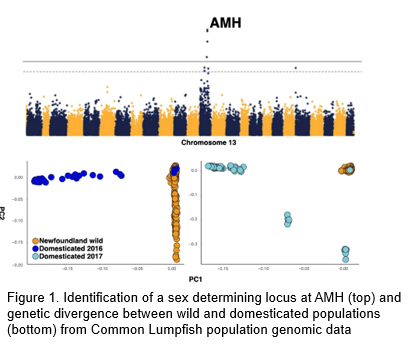DEVELOPMENT OF A CHROMSOME-SCALE REFERENCE GENOME AND POPULATION GENOMIC DATA TO CHARACTERIZE SIGANTURES OF SEX AND EARLY DOMESTICATION IN LUMPFISH Cyclopterus lumpus
Parasite infections in Atlantic Salmon aquaculture pose a significant challenge to salmon aquaculture and cleaner-fish species and have become an integral part of sea lice management in salmon aquaculture. The Common Lumpfish (Cyclopertus lumpus) are the most frequently used cleaner-fish species and increasingly the subject of targeted breeding programs to meet a growing industry demand. However, genomic resources for this species have been lacking, limiting genomics-informed improvement, and restricting the conservation of wild Lumpfish, currently at risk in the core of their Canadian range off southern Newfoundland. Here, we develop the first chromosome-scale reference genome for Lumpfish in the Northwest Atlantic, and in conjunction with whole genome resequencing and SNP array data, explore the basis of sex determination and signatures of early domestication in a Newfoundland population.
Our genome assembly resolves 25 chromosomes, and in conjunction with population level genomic and transcriptomic data, we identify a putative male sex determining locus (i.e., anti-Müllerian hormone (AMH) on chromosome 13 (Figure 1, top), providing the potential for genetic based sex identification in future. In addition, whole genome comparisons of wild and domesticated Lumpfish from Newfoundland revealed extensive and year-class specific genomic differentiation despite only a few generations in captivity (Figure 1, bottom).
Genomic regions divergent between wild and domestic Lumpfish include regions associated with climatic variation in Newfoundland populations, and highlight the potential for future maladaptation of wild populations impacted by interbreeding with escaped domestic individuals. Together, these results reveal the utility of genomic resources in identifying genomic signatures of sex and early domestication differences within Lumpfish and will aid in future improvement and management of this species.
